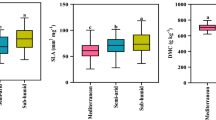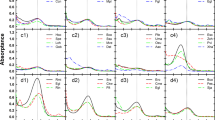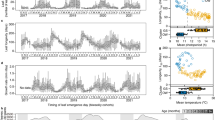Abstract
IN trifoliate species of Ranunculus the first-formed and juvenile leaves are undivided, and as the plants mature the adult trifoliate or biternate condition is gradually taken up by new leaves. Quite frequently, however, some of the later leaves of mature plants show a partial reversion to a less divided, more juvenile form. This reversion may occur in leaves of similar age in many plants in a single area, which suggests a temporary or seasonal environmental cause.
This is a preview of subscription content, access via your institution
Access options
Subscribe to this journal
Receive 51 print issues and online access
$199.00 per year
only $3.90 per issue
Buy this article
- Purchase on Springer Link
- Instant access to full article PDF
Prices may be subject to local taxes which are calculated during checkout
Similar content being viewed by others
References
N.Z. J. Sci. and Tech., B, 35, 279 (1953).
Author information
Authors and Affiliations
Rights and permissions
About this article
Cite this article
FISHER, F. Effect of Temperature on Leaf-shape in Ranunculus . Nature 173, 406–407 (1954). https://doi.org/10.1038/173406b0
Issue Date:
DOI: https://doi.org/10.1038/173406b0
This article is cited by
-
Responses of ivy (Hedera helix L.) to combinations of gibberellic acid, paclobutrazol and abscisic acid
Plant Growth Regulation (1990)
-
The anatomy of tissue cultured red raspberry prior to and after transfer to soil
Plant Cell, Tissue and Organ Culture (1985)
-
Temperature Dependent Leaf Morphogenesis in Ranunculus flabellaris
Nature (1967)
-
Anatomical Changes associated with Juvenile-to-Mature Growth Phase Transition in Hedera
Nature (1965)
-
Effect of Temperature and Potassium Gibberellate on Phases of Growth of Algerian Ivy
Nature (1961)
Comments
By submitting a comment you agree to abide by our Terms and Community Guidelines. If you find something abusive or that does not comply with our terms or guidelines please flag it as inappropriate.



